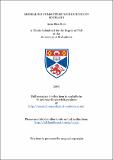Files in this item
Modelling commuters' mode choice in Scotland
Item metadata
| dc.contributor.advisor | Boyle, Paul | |
| dc.contributor.advisor | Fitzroy, Felix | |
| dc.contributor.advisor | Jensen-Butler, Chris | |
| dc.contributor.author | Hole, Arne Risa | |
| dc.coverage.spatial | iii, 216 p. | en_US |
| dc.date.accessioned | 2018-06-15T12:28:10Z | |
| dc.date.available | 2018-06-15T12:28:10Z | |
| dc.date.issued | 2005 | |
| dc.identifier.uri | https://hdl.handle.net/10023/14115 | |
| dc.description.abstract | This thesis contributes to the literature on the choice of transport mode for commuting trips, with special focus on the difference between urban and rural commuting in Scotland. The thesis begins by giving an overview of discrete choice theory and some empirical models consistent with this theory, before reviewing the literature on empirical applications of mode choice models for commuting trips. In the following, multinomial, nested and mixed logit models using data from a survey of commuters in the University of St Andrews are developed. The models are used to estimate aggregate mode-choice elasticities that can assist the development of efficient car reduction policies in St Andrews and other small towns in rural areas. The direct elasticities of the car mode are found to be comparable to estimates reported in studies of urban commuting, while the demand for public transport is found to be considerably more elastic. The value of in-vehicle travel time is found to be lower than in most studies of urban commuting, reflecting that the roads in the St Andrews area are relatively uncongested. Subsequently, current car drivers' willingness to use a Park and Ride service prior to the implementation of such a service are examined. The results show that the modal shift away from parking on-site will be small unless the new service is accompanied by measures aimed at making parking on-site less attractive such as introducing parking charges. Finally, the effect of the 'compact city' on modal split and congestion are examined. As well as making urban transport more sustainable as a result of an increase in the use of public transport, making cities more compact is found to contribute to lower levels of congestion in urban areas through a reduction in complex trip chains. | en_US |
| dc.language.iso | en | en_US |
| dc.publisher | University of St Andrews | |
| dc.subject.lcc | HE336.C5H7 | |
| dc.subject.lcsh | Choice of transportation--Mathematical models | en |
| dc.subject.lcsh | Choice of transportation--Scotland | en |
| dc.subject.lcsh | Commuting--Mathematical models | en |
| dc.subject.lcsh | Commuters--Scotland--Attitudes | en |
| dc.title | Modelling commuters' mode choice in Scotland | en_US |
| dc.type | Thesis | en_US |
| dc.type.qualificationlevel | Doctoral | en_US |
| dc.type.qualificationname | PhD Doctor of Philosophy | en_US |
| dc.publisher.institution | The University of St Andrews | en_US |
This item appears in the following Collection(s)
Items in the St Andrews Research Repository are protected by copyright, with all rights reserved, unless otherwise indicated.

